Restoration, Indicators, and Participatory Solutions: Addressing Water Scarcity in Mediterranean Agriculture
Abstract
1. Introduction
2. Materials and Methods
- -
- -
- Soil sampling in two farms (Organic Farm = OF and Conventional Farm = CF), with 3 and 2 sampling sites, respectively, repeated during two different seasons (winter 2023 and summer 2024) to evaluate different data for environmental changes, especially for water availability (Table 1). In total, 10 soil samples were collected at depths between 0–25 and 0–30 cm through a manual auger, numbering them by starting with the winter season (w) and the organic (OF1w, OF2w, and OF3w) and conventional (CF1w and CF2w) farms and followed by the summer season (s), always starting with the organic farm (OF1s, OF2s, and OF3s) and followed by the conventional farms (CF1s and CF2s). After collecting samples, soils were air dried and crushed with a mortar prior to sieving at 2 mm size. Soil analysis was performed by the Laboratory of agricultural and environmental chemistry of CIHEAM Bari. The particle-size distribution analysis was performed using the pipette method [21], while the textural class was defined according to the USDA classification. Soil pH was determined in water and saline solution (CaCl2 0.01 M) at 1:2.5, w/v. Electrical conductivity (EC) was measured on soil water extracts (1:2, w/v). Soil organic C was determined by the Walkley and Black method [22], while total N was measured following the Kjeldahl method [23]. Available P was measured on sodium bicarbonate alkaline soil extracts and measured by the Olsen method [24]. Total carbonate content was quantified using a Dietrich–Fruhling calcimeter apparatus, and the exchangeable bases (K, Ca, Mg, and Na) were extracted with barium chloride and triethanolamine solution and quantified by ICP-OES.
- -
- Three stakeholder Italian pilot area meetings were held for the evaluation of critical issues and solutions to be adopted [7 February 2023, 3 October 2023, 6 December 2024]. Each meeting included the presence of two stakeholder groups with different roles and expertise, first representing the issues raised in the discussion for each individual group and then the solutions to be adopted in the topics proposed by the REACT4MED project. The characteristics of the stakeholders and their affiliations, genders, and ages are highlighted in Table 2.
2.1. First Stakeholder Meeting
2.2. Second Stakeholders’ Meeting
2.3. Third Stakeholders’ Meeting
2.4. Identification of Indicators
3. Results and Discussion
3.1. Biolime, Potential Vegetation, and Land Use
3.2. Soil Analysis
| Farm | Organic Farm | Conventional Farm | |||||||||
|---|---|---|---|---|---|---|---|---|---|---|---|
| Samples code | OF1w | OF2w | OF3w | OF1s | OF2s | OF3s | CF1w | CF2w | CF1s | CF2s | |
| Date | 18 December 2023 | 18 December 2023 | 18 December 2023 | 18 July 2024 | 18 July 2024 | 18 July 2024 | 18 December 2023 | 18 December 2023 | 18 July 2024 | 18 July 2024 | |
| Geographic coordinates (UTM 33T m) | 656,852 E 4,474,979 N | 656,923 E 4,474,550 N | 657,233 E 4,474,691 N | 656,852 E 4,474,979 N | 656,923 E 4,474,550 N | 657,233 E 4,474,691 N | 657,031 E 4,478,547 N | 657,127 E 4,478,495 N | 657,031 E 4,478,547 N | 657,127 E 4,478,495 N | |
| Season of year 2024 | unit | Winter | Winter | Winter | Summer | Summer | Summer | Winter | Winter | Summer | Summer |
| Variety of table grapes | Autumn Crisp | Arra 30 | Sweet Globe | Autumn Crisp | Arra 30 | Sweet Globe | Regal | Autumn Crisp | Regal | Autumn Crisp | |
| Depths | cm | 25 | 30 | 30 | 30 | 30 | 30 | 30 | 30 | 30 | 30 |
| Sand (2–0.05 mm) | g/kg−1 | 55 | 64 | 46 | 29 | 76 | 44 | 753 | 482 | 752 | 481 |
| Silt (0.05–0.002 mm) | g/kg−1 | 525 | 581 | 500 | 496 | 587 | 492 | 245 | 512 | 150 | 309 |
| Clay (<0.002 mm) | g/kg−1 | 420 | 355 | 454 | 475 | 337 | 465 | 2 | 6 | 98 | 210 |
| Textural Class (USDA) | - | Silty-Clay | Silty-Clay | Silty-Clay | Silty-Clay | Silty-Clay | Silty-Clay | Sandy Loam | Loam | Sandy Loam | Loam |
| pH (H2O 1:2.5) | - | 8.4 | 8.4 | 8.2 | 8.5 | 8.5 | 8.5 | 8.1 | 8.3 | 7.7 | 8.5 |
| pH (CaCl2 1:2.5) | - | 7.6 | 7.7 | 7.4 | 7.7 | 7.6 | 7.7 | 7.2 | 7.5 | 6.9 | 7.6 |
| Electrical conductivity (1:2 25 °C) | dS/m | 0.2 | 0.3 | 0.4 | 0.2 | 0.3 | 0.3 | 0.1 | 0.1 | 0.4 | 0.3 |
| Total Carbonate | g/kg−1 | 165 | 174 | 146 | 176 | 187 | 175 | 3 | 67 | 1 | 83 |
| Organic Carbon | g/kg−1 | 13.6 | 9.4 | 13.0 | 9.9 | 11.2 | 12.0 | 6.2 | 5.9 | 4.7 | 7.5 |
| Organic Matter | g/kg−1 | 23.5 | 16.2 | 22.4 | 17.0 | 19.2 | 20.6 | 10.7 | 10.2 | 8.0 | 12.9 |
| Total Nitrogen | g/kg−1 | 1.4 | 1.1 | 1.3 | 1.5 | 1.1 | 1.3 | 0.7 | 0.9 | 0.6 | 0.9 |
| C/N ratio | - | 9.9 | 8.6 | 9.8 | 6.4 | 9.8 | 9.4 | 8.3 | 6.5 | 7.4 | 7.9 |
| Available P | mg/kg−1 | 24 | 10 | 12 | 20 | 19 | 15 | 38 | 34 | 72 | 40 |
| Available P2O5 | mg/kg−1 | 55 | 24 | 27 | 45 | 43 | 34 | 86 | 77 | 164 | 91 |
| Exchangeable K | mg/kg−1 | 566 | 357 | 462 | 356 | 393 | 394 | 120 | 320 | 66 | 298 |
| Exchangeable Ca | mg/kg−1 | 4611 | 3980 | 5076 | 4461 | 3693 | 4614 | 1005 | 3430 | 1020 | 3410 |
| Exchangeable Mg | mg/kg−1 | 515 | 522 | 465 | 602 | 563 | 519 | 111 | 381 | 186 | 467 |
| Exchangeable Na | mg/kg−1 | 87 | 195 | 197 | 137 | 162 | 176 | 55 | 63 | 134 | 201 |
3.3. Stakeholder Engagement and Participatory Workshops
| Name of Organization (Participant List) | Gender | Age Group (Years) | Stakeholder Group | Workshop Meeting | ||
|---|---|---|---|---|---|---|
| 1st | 2nd | 3rd | ||||
| CIHEAM-Bari | Male | >50 | organization | x | x | x |
| CIHEAM-Bari | Female | 30–50 | organization | x | ||
| CIHEAM-Bari | Male | 30–50 | organization | x | x | x |
| Softwater | Male | 30–50 | organization | x | ||
| Apulia Region | Male | 30–50 | 1 | x | x | x |
| Apulia Region | Male | 30–50 | 1 | x | x | |
| Consortium of Taranto | Male | >50 | 1 | x | x | x |
| Consortium of Taranto | Male | 30–50 | 1 | x | ||
| Consortium of Taranto | Male | 30–50 | 1 | x | ||
| Regional Basin Authority | Male | 30–50 | 1 | x | ||
| ARPA, Taranto District | Female | 30–50 | 1 | x | ||
| Apulia Region | Male | >50 | 2 | x | x | |
| Farmer | Male | >50 | 2 | x | ||
| Consortium of Taranto | Male | 30–50 | 2 | x | ||
| Technician programmer | Male | >50 | 2 | x | ||
| Nat. Res. Center-IRSA | Male | 30–50 | 1 | x | x | |
| Nat. Res. Center-IRSA | Male | 30–50 | 2 | x | ||
| Nat. Res. Center-ISPA | Female | >50 | 1 | x | x | |
| University of Bari | Female | ≤30 | 1 | x | ||
| Agrotechnician | Male | >50 | 2 | x | x | |
| Agrotechnician | Male | 30–50 | 1 | x | ||
| Taranto Province | Male | >50 | 2 | x | ||
| Farmer | Female | 30–50 | 2 | x | ||
| Farmer | Female | ≤30 | 1 | x | ||
| Farmer | Male | >50 | 1 | x | ||
| Agrotechnician | Male | >50 | 1 | x | ||
| Total | 30 | 14 | 14 | 11 | ||
- -
- The first stakeholders’ meeting (Massafra, 7 February 2023). During the first session, stakeholders expressed their thoughts in very inspiring drawings. Then, a representative for each group showed their findings in the plenary session. The second session focused on the identification of the solutions to the previously defined problems. Each stakeholder received moderation cards in two different colors, representing actions and indicators. At the end of the session, the results were presented in the plenary by a group representative and subsequently used as feedback for the multi-operational Land degradation Decision-Support Toolbox (LanDS) developed in the framework of the project to provide harmonized land degradation assessment and impact evaluation of restoration measures.
- -
- The second workshop meeting (CIHEAM Bari, 3 October 2023). Since some of the participants did not attend the first workshop, the context of the REACT4MED project was presented, emphasizing the source of financing, the focus on restoration actions, and partnerships. Specifically, the objectives of the Italian pilot area were shown to focus on (a) improving the sustainable management of land and water to support greater agricultural productivity, (b) accelerating innovation and technological diffusion, and (c) reversing land degradation. In addition, the main outcomes of the first stakeholders’ workshop were presented. This introduction was essential to allow the participants a better understanding of the main goal of the workshop: to describe a future vision of the agricultural system in 2043 (working on defining the needs of the agricultural system and the main differences compared to the current situation in the pilot area). The focus of the workshop was related to the agricultural sector, taking into consideration that the pilot area of Stornara and Tara is an irrigation consortium. The agenda for the working day was as follows:
- (a)
- Description of the exercise. Taking into consideration the roles and institutions of the stakeholders, two groups were formed, ensuring (i) the same number of participants per group, (ii) at least one woman in each group, and (iii) a representative from the agricultural sector in each group. Both groups worked to create their vision for the future.
- (b)
- The first step of the exercise was the explanation of what a vision is, what the main prerequisites are, the guiding principles, and the guiding questions for our specific case study. To open the participant’s mind to the envisioning process, a short narrative was read. Then, stakeholders were invited to design an inspiring and personal vision by writing their ideas on moderation cards, after which each shared his/her idea. The final step was to work in groups: stakeholders were left free to create and discuss a desirable common vision, by using cards, writing, or drawings on a big sheet of paper to express their perception.
- -
- The third stakeholders’ meeting (CIHEAM Bari, 6 December 2024). The focus of the workshop was related to the agricultural sector, taking into consideration that the pilot area of Stornara and Tara is an irrigation consortium. With nine participants in total, we decided to let them work in a single group. The first step of the exercise was the presentation in the plenary of PowerPoint slides about the social justice inquiry and what was expected of participants. Then, the facilitators encouraged the group to reflect on the impact of the restoration action proposed for the pilot area, that is “Organic agriculture”, and contribute their personal views on relevant costs and benefits, how these costs and benefits are distributed across actor groups, and finally, what effect this has on the community. Participants were asked to write their inputs directly on the matrix. The activity was animated by a stimulating discussion among all participants, who contributed actively to compiling the matrix.
- Mismatch between crop types and local pedoclimatic conditions, due to limited suitability assessments.
- The continuous collection of soil data to establish efficient irrigation and nutrition scheduling through fertigation.
- It was clear that many farmers use groundwater through private wells for irrigation, but when this process occurs along the coast, it causes saline water intrusion, which is associated with soil salinity buildup. Furthermore, the water withdrawn from the wells compared to that supplied by the consortium is of poor quality due not only to salinity but also to chemical contaminants originating from the use of petrol in agricultural machinery.
- It was emphasized to increase water-storing capacities with new reservoirs by collecting good-quality water useful for irrigation as alternative sources of rainwater. The largest amount of water volumes in the pilot area are coming from sources external to the Apulia Region’s territory (rivers and reservoirs are in the bordering Basilicata region). The water amount allocated to the consortium is a fixed quota not dependent on the irrigation volumes required by farmers. Consequently, during the summer seasons, it is difficult for the consortium to satisfy the requests.
- Improve the efficiency of water resources management through innovation and precision agriculture (e.g., network georeferencing and modern technologies), as well as training of specialized technicians.
- Finance technological innovation (e.g., use of drones, weather stations, laboratory analysis) to optimize water use based on soil and climate conditions to increase the efficient use of water and fertilizers.
- Improvement and lessening of the regulatory framework and bureaucratic procedures to supply water when it is needed by the sector operators.
- Stakeholders proposed actionable strategies aligned with REACT4MED’s objectives to reverse land degradation while ensuring agricultural productivity: the territory must fully connect with intersectoral policies of tourism and the environment. The governance inside the irrigation consortium of Stornara and Tara is participatory and must be based on farmers and producers managing water supply based on their requests.
- Applying cultivation techniques properly, suggested by the ensured technical assistance in a sustainable vision, such as:
- ➢
- Reducing the number of times the land is plowed each year.
- ➢
- Enhancing plant diversity by planting local aromatic and medicinal plants along field edges.
- ➢
- Making compost from agricultural waste along with manure and humus produced on the farm.
- ➢
- Using natural methods to manage plant diseases.
- ➢
- Minimizing reliance on heavy machinery, which can harm soil structure and damage plant roots and beneficial microorganisms.
- ➢
- Adopting agricultural practices that improve soil health by increasing organic matter and preventing excessive water accumulation in the fields.
- Farmers’ production must be oriented to the yield of typical local crops and protected by trademark certification to enhance inclusion in foreign but also niche markets. Overall, the farming system is dominated by table grape production.
- Economic sustainability must be fully combined with environmental sustainability: technological innovation serves to ensure alternative (non-conventional) forms of water sources.
- The crops produced in the area must be suited to the pedoclimatic conditions, respecting the vocation of the territory, fit for high-quality produce, and characterized by rich agro-biodiversity. These basic elements allow a productive agricultural system of quality winemaking, olive growing, and horticulture.
- The local community must be fully engaged in the territorial development, highlighting well-working social sustainability. People have easy access to real-time information (technical, social, economic, and legal) on how to start a farm business, what the territory offers, and how to enhance it with specialized technical support.
- The land regime must avoid fragmentation, and farmers must be involved in cooperatives and benefit from loan forms and optimal solutions from an economic point of view since they are more stable, which allows for more effective implementation of strategies and policies.
- People must have full use of the agricultural lands, confirming the multifunctional role of such a sector not only for food security but also as a place to spend good times and enjoy excellent local products.
3.4. Expected Benefits from Restoration Actions and Best Practices
- Reducing soil tillage to maintain the natural soil structure and therewith water retention.
- Enhancing plant diversity by planting local aromatic and medicinal plants along field edges to reduce harmful pathogens and avoid chemical inputs to the farm, which reduces the risk of salinization.
- Abstinence from mineral fertilizers.
- Decreasing the risk of salinization.
- Using compost and manure as fertilizers.
- Increasing soil organic matter and water retention.
- Minimizing reliance on heavy machinery.
- Protecting soil structure and plant roots and thereby improving water intake by plants.
- Covering bare soils by intercropping or mulching.
- Decreasing evaporation.
- Increasing soil organic matter and therewith water retention and soil health.
- Preventing excessive water accumulation in the fields through the adoption of canalizations and well recovery.
- Decreasing the risk of salinization.
3.5. Indicators
- Soil quality and effect of salt stress on crop yield (or water stress index), useful for defining crop tolerance to soil salinity.
- Socio-economic indicators to evaluate and define data on agricultural income of the main crops grown in the pilot area, market opportunities and obstacles to change, labor shortages, and the role of youth and women in agriculture.
- Weed management along drainage channels.
- Conservation of plant biodiversity in the surrounding areas to prevent attacks by current and future pathogens,
- Climatic analysis of extreme events.
- Climate risk and vulnerability assessment to ensure it is proportionate to the scope of the activity and the expected duration.
- Early warning systems.
3.6. Implications and Recommendations
- Reduction in tillage frequency to preserve soil structure and enhance water retention.
- Enhancement of plant biodiversity through the inclusion of local aromatic and medicinal species to improve soil health and pest management.
- Use of organic amendments (compost, manure) to increase soil organic matter and correct nutrient imbalances.
- Implementation of precision irrigation scheduling informed by continuous soil and climate monitoring to optimize water use efficiency.
- Mitigation of groundwater salinization by improving water sourcing and storage infrastructure.
- Strengthening participatory governance and technical support to ensure the adoption of sustainable practices aligned with local conditions.
4. Conclusions
Author Contributions
Funding
Institutional Review Board Statement
Informed Consent Statement
Data Availability Statement
Conflicts of Interest
References
- Zdruli, P.; Zucca, C. Maintaining soil health in dryland areas. In Managing Soil Health for Sustainable Agriculture; Reicosky, D., Ed.; Managing Soil Health for Sustainable Agriculture Vol. 1: Fundamentals; Burleigh and Dods Science Publishing: Cambridge, UK, 2018. [Google Scholar] [CrossRef]
- Jain, S.; Srivastava, A.; Khadke, L.; Chatterjee, U.; Elbeltagi, A. Global-scale water security and desertification management amidst climate change. Environ. Sci. Pollut. Res. 2024, 31, 58720–58744. [Google Scholar] [CrossRef]
- Hu, T.; Li, K.; Xiong, K.; Wang, J.; Yang, S.; Wang, Z.; Gao, A.; Yu, X. Research progress on water–fertilizer coupling and crop quality improvement and its implication for the karst rock desertification control. Agronomy 2022, 12, 903. [Google Scholar] [CrossRef]
- Duarte, R.; Pinilla, V.; Serrano, A. The globalization of Mediterranean agriculture: A long-term view of the impact on water consumption. Ecol. Econ. 2021, 183, 106964. [Google Scholar] [CrossRef]
- Arora, S.; Bhatt, R.; Sharma, V.; Hadda, M.S. Indigenous practices of soil and water conservation for sustainable hill agriculture and improving livelihood security. Environ. Manag. 2023, 72, 321–332. [Google Scholar] [CrossRef] [PubMed]
- Visser, M.A.; Kumetat, G.; Scott, G. Drought, water management, and agricultural livelihoods: Understanding human-ecological system management and livelihood strategies of Farmer’s in rural California. J. Rural. Stud. 2024, 109, 103339. [Google Scholar] [CrossRef]
- D’Agostino, D.; Borg, M.; Hallett, S.H.; Sakrabani, R.S.; Thompson, A.; Papadimitriou, L.; Knox, J.W. Multi-stakeholder analysis to improve agricultural water management policy and practice in Malta. Agric. Water Manag. 2020, 229, 105920. [Google Scholar] [CrossRef]
- Purvis, L.; Dinar, A. Are intra-and inter-basin water transfers a sustainable policy intervention for addressing water scarcity? Water Secur. 2020, 9, 100058. [Google Scholar] [CrossRef]
- Eekhout, J.P.C.; Delsman, I.; Baartman, J.E.M.; van Eupen, M.; van Haren, C.; Contreras, S.; Martínez-López, J.; de Vente, J. How future changes in irrigation water supply and demand affect water security in a Mediterranean catchment. Agric. Water Manag. 2024, 297, 108818. [Google Scholar] [CrossRef]
- Perrino, E.V.; Ladisa, G.; Calabrese, G. Flora and plant genetic resources of ancient olive groves of Apulia (southern Italy). Genet. Resour. Crop Evol. 2014, 61, 23–53. [Google Scholar] [CrossRef]
- Perrino, E.V.; Calabrese, G. Endangered segetal species in southern Italy: Distribution, conservation status, trends, actions and ethnobotanical notes. Genet. Resour. Crop Evol. 2018, 65, 2107–2134. [Google Scholar] [CrossRef]
- Asad, M.; Mahmood, Z.; Mudassar, M.; Arshad, A.; Raza, M.U.; Anum, W. Bio-economic assessment of non-chemical weed management strategies in minor crops: A review on Weed research issues, challenges, and opportunities in Pakistan. J. Res. Weed Sci. 2019, 2, 127–140. [Google Scholar] [CrossRef]
- Mattas, K.; Nastis, S.A.; Michailidis, A.; Tsakiridou, E.; Spyridon, K. Unveiling the hidden gems: Minor crops as catalysts for sustainable development, biodiversity conservation, and economic resilience. Sustain. Dev. 2024, 32, 4748–4757. [Google Scholar] [CrossRef]
- Salvia, R.; Quaranta, V.; Sateriano, A.; Quaranta, G. Land resource depletion, regional disparities, and the claim for a renewed ‘sustainability thinking’under early desertification conditions. Resources 2022, 11, 28. [Google Scholar] [CrossRef]
- Tsesmelis, D.E.; Karavitis, C.A.; Kalogeropoulos, K.; Zervas, E.; Vasilakou, C.G.; Skondras, N.A.; Oikonomou, P.D.; Stathopoulos, N.; Alexandris, S.G.; Tsatsaris, A.; et al. Evaluating the degradation of natural resources in the Mediterranean environment using the water and land resources degradation index, the case of Crete Island. Atmosphere 2022, 13, 135. [Google Scholar] [CrossRef]
- Aboukota, M.E.S.; Hassaballa, H.; Elhini, M.; Ganzour, S.K. Land Degradation, Desertification & Environmental Sensitivity to Climate Change in Alexandria and Beheira, Egypt. Egypt. J. Soil. Sci. 2024, 64, 167–180. [Google Scholar]
- REACT4MED (Restoration Action for Mediterranean) Project. Available online: https://react4med.eu/ (accessed on 24 February 2025).
- García, J.E.A.; Yazici, B.; Richa, A.; Touil, S.; Díaz, V.J.R.; Ramallo-González, A.P.; Gómez, A.F.S. Digitalising governance processes and water resources management to foster sustainability strategies in the Mediterranean agriculture. Environ. Sci. Policy 2024, 158, 103805. [Google Scholar] [CrossRef]
- Blasi, C. La Vegetazione D’italia Con Carta Delle Serie di Vegetazione in Scala 1:500.000; Palombi Editore: Roma, Italy, 2010; p. 539. [Google Scholar]
- SIT (Territorial Information System). Available online: https://pugliacon.regione.puglia.it/web/sit-puglia-sit (accessed on 9 October 2024).
- Gee, G.W.; Bauder, J.W. Particle-size analysis. In Methods of Soil Analysis. Part 1. Agronomy Monograph 9, 2nd ed; Klute, A., Ed.; ASA, SSSA: Madison, WI, USA, 1986; pp. 383–411. [Google Scholar]
- Nelson, D.W.; Sommers, L.E. Total Carbon, Organic Carbon, and Organic Matter. In Methods of Soil Analysis. Part 3. Chemical Methods; Sparks, D.L., Ed.; SSSA: Madison, WI, USA, 1996; pp. 961–1010. [Google Scholar]
- Bremner, J.M. Nitrogen total. In Methods of Soil Analysis. Part 3. Chemical Methods; Sparks, D.L., Ed.; SSSA: Madison, WI, USA, 1996; pp. 1085–1121. [Google Scholar]
- Olsen, S.R.; Sommers, L.E. Determination of available phosphorus. In Methods of Soil Analysis: Chemical and Microbiological Properties; Page, R.L., Miller, R.H., Keeney, D.R., Eds.; American Society of Agronomy: Madison, WI, USA, 1982; pp. 404–430. [Google Scholar]
- Wang, R.; Sun, Q.; Chang, Q. Soil Types Effect on Grape and Wine Composition in Helan Mountain Area of Ningxia. PLoS ONE 2015, 10, e0116690. [Google Scholar] [CrossRef]
- Echeverría, G.; Ferrer, M.; Mirás-Avalos, J. Effects of soil type on vineyard performance and berry composition in the Río de la Plata Coast (Uruguay). OENO One 2017, 51. [Google Scholar] [CrossRef]
- Gerke, J. The Central Role of Soil Organic Matter in Soil Fertility and Carbon Storage. Soil. Syst. 2022, 6, 33. [Google Scholar] [CrossRef]
- Singh, N.K.; Sachan, K.; Ranjitha, G.; Chandana, S.; Manoj, B.P.; Panotra, N.; Katiyar, D. Building soil health and fertility through organic amendments and practices: A review. Asian J. Soil. Sci. Plant Nutr. 2024, 10, 175–197. [Google Scholar] [CrossRef]
- Fan, H.; Wali, F.; Hu, P.; Dong, H.; Li, H.; Liang, D.; Shen, J.; Gao, M.; Feng, H.; Sun, B. Sustainable phosphorus (P) management: Impact of low P input with enhancement measures on soil P fractions and crop yield performance on a calcareous soil. J. Integr. Agric. 2025. [Google Scholar] [CrossRef]
- Mpelasoka, B.S.; Schachtman, D.P.; Treeby, M.T.; Thomas, M.R. A review of potassium nutrition in grapevines with special emphasis on berry accumulation. Aust. J. Grape Wine Res. 2003, 9, 154–168. [Google Scholar] [CrossRef]
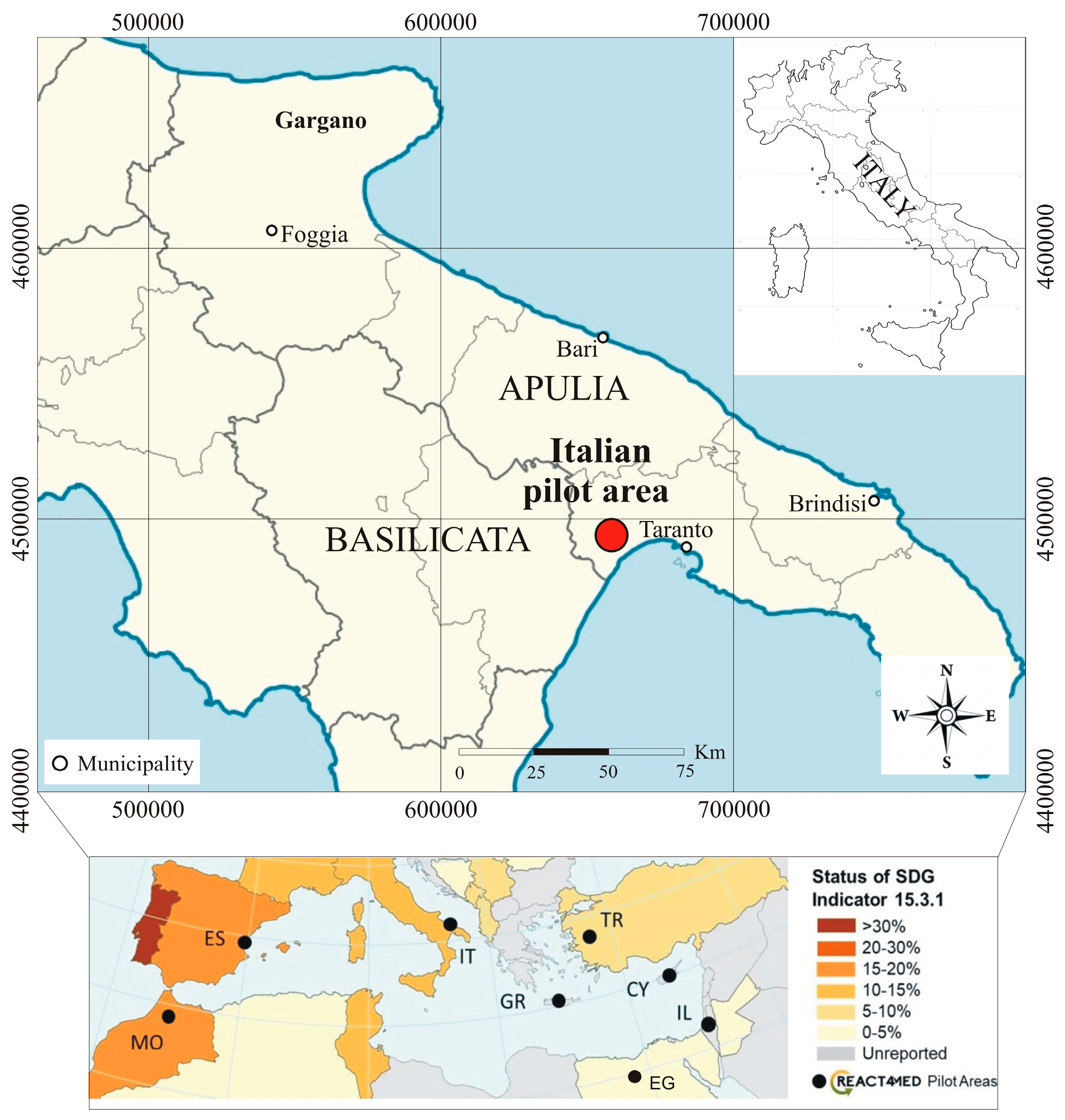
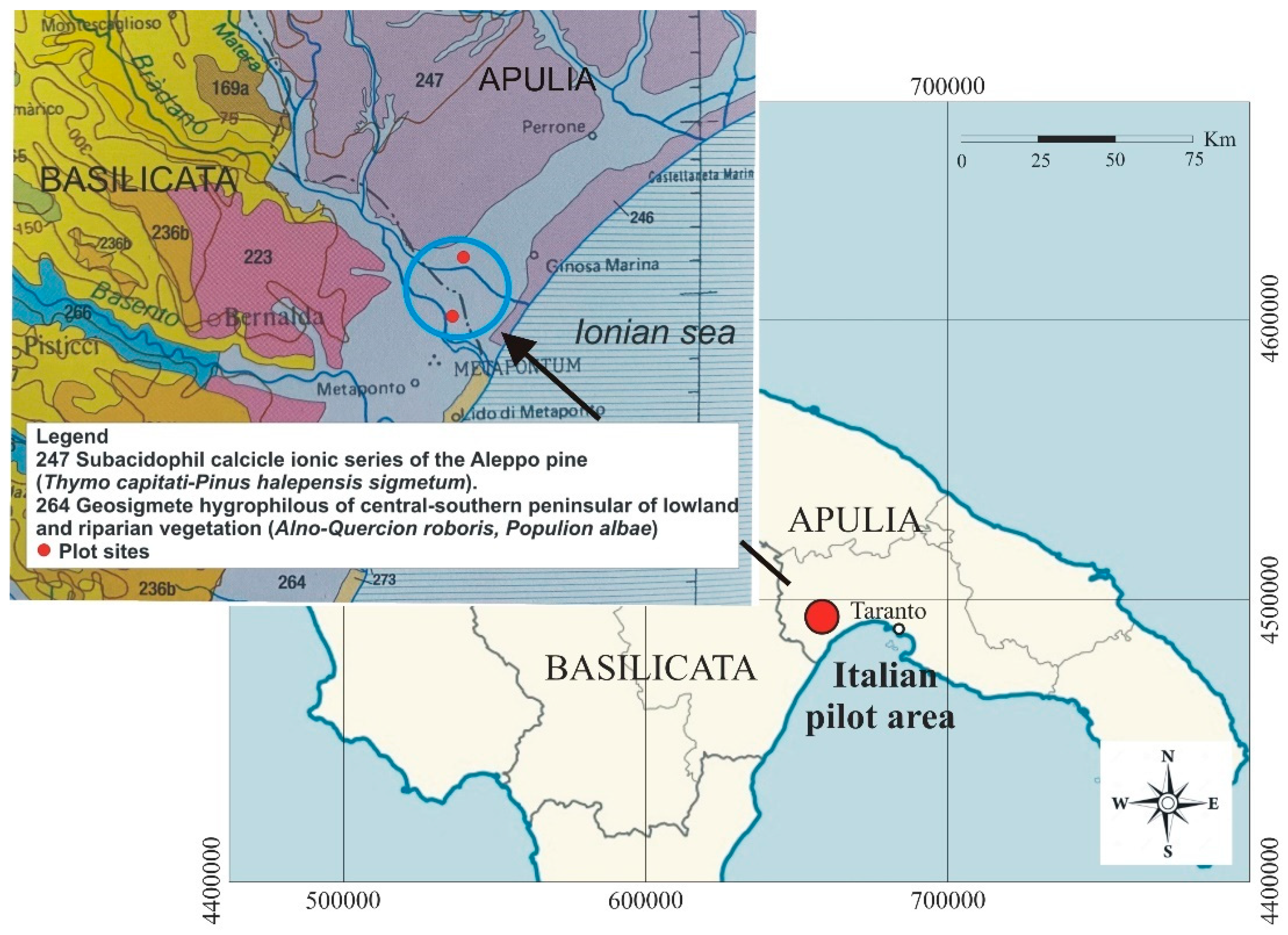
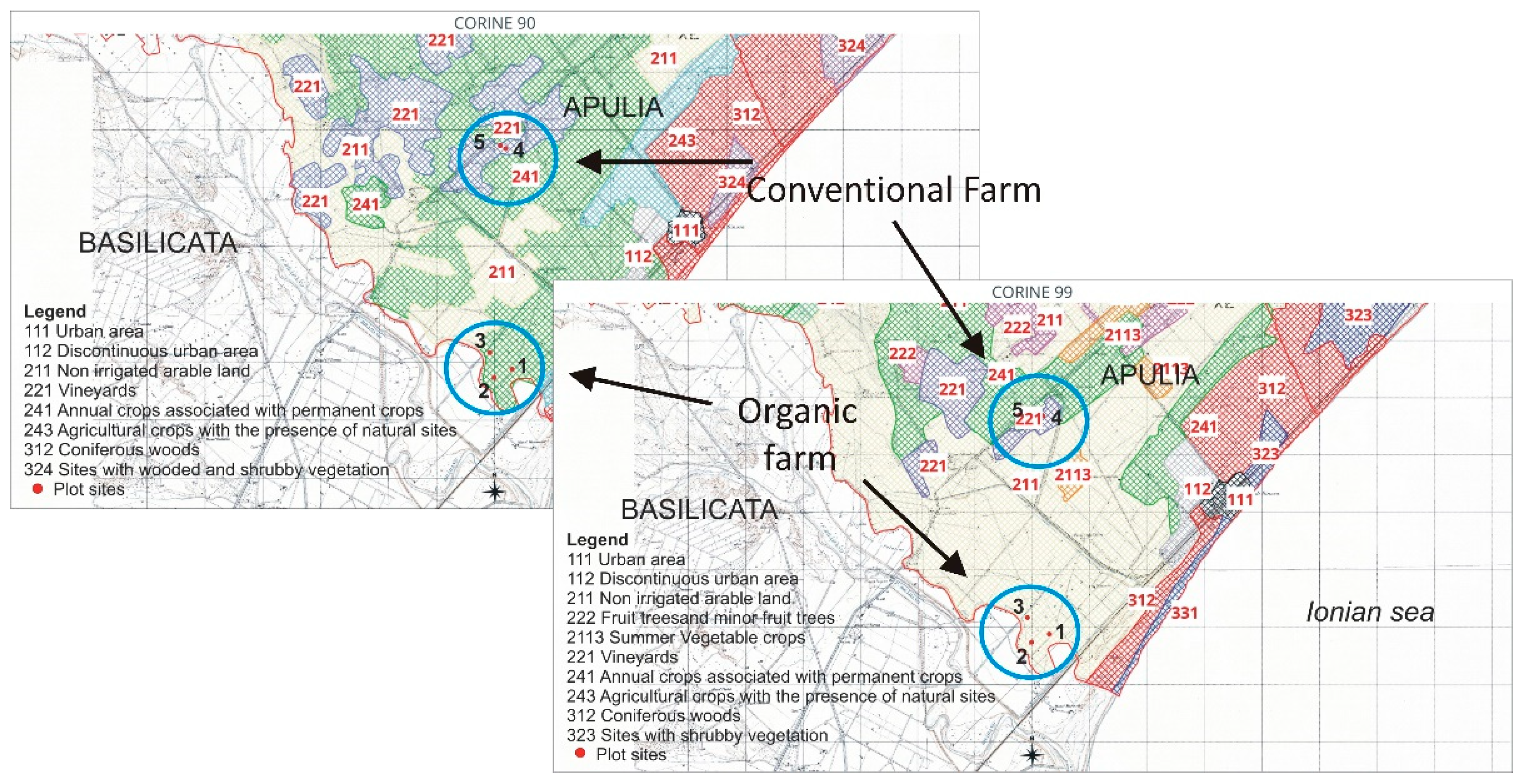
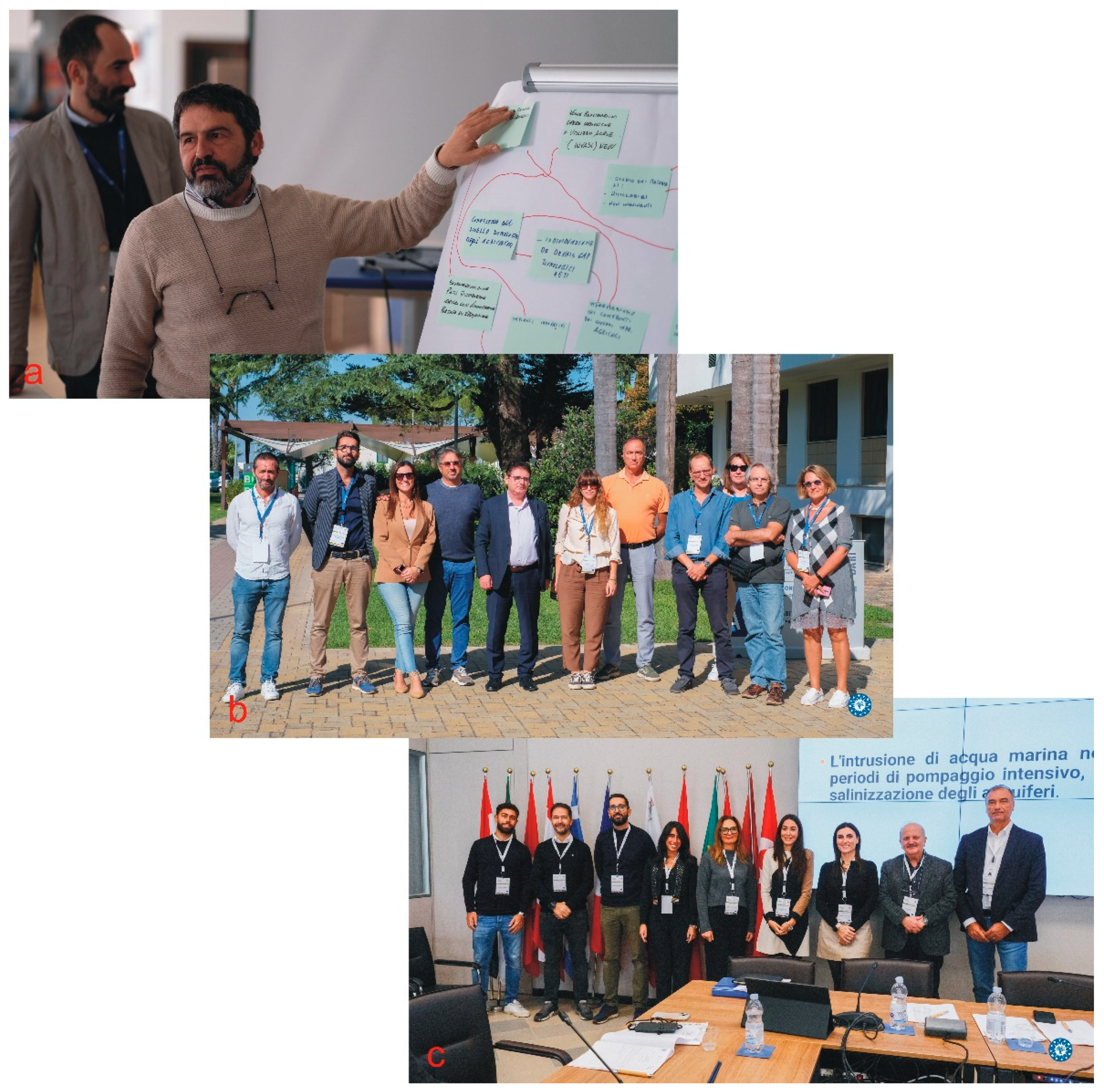
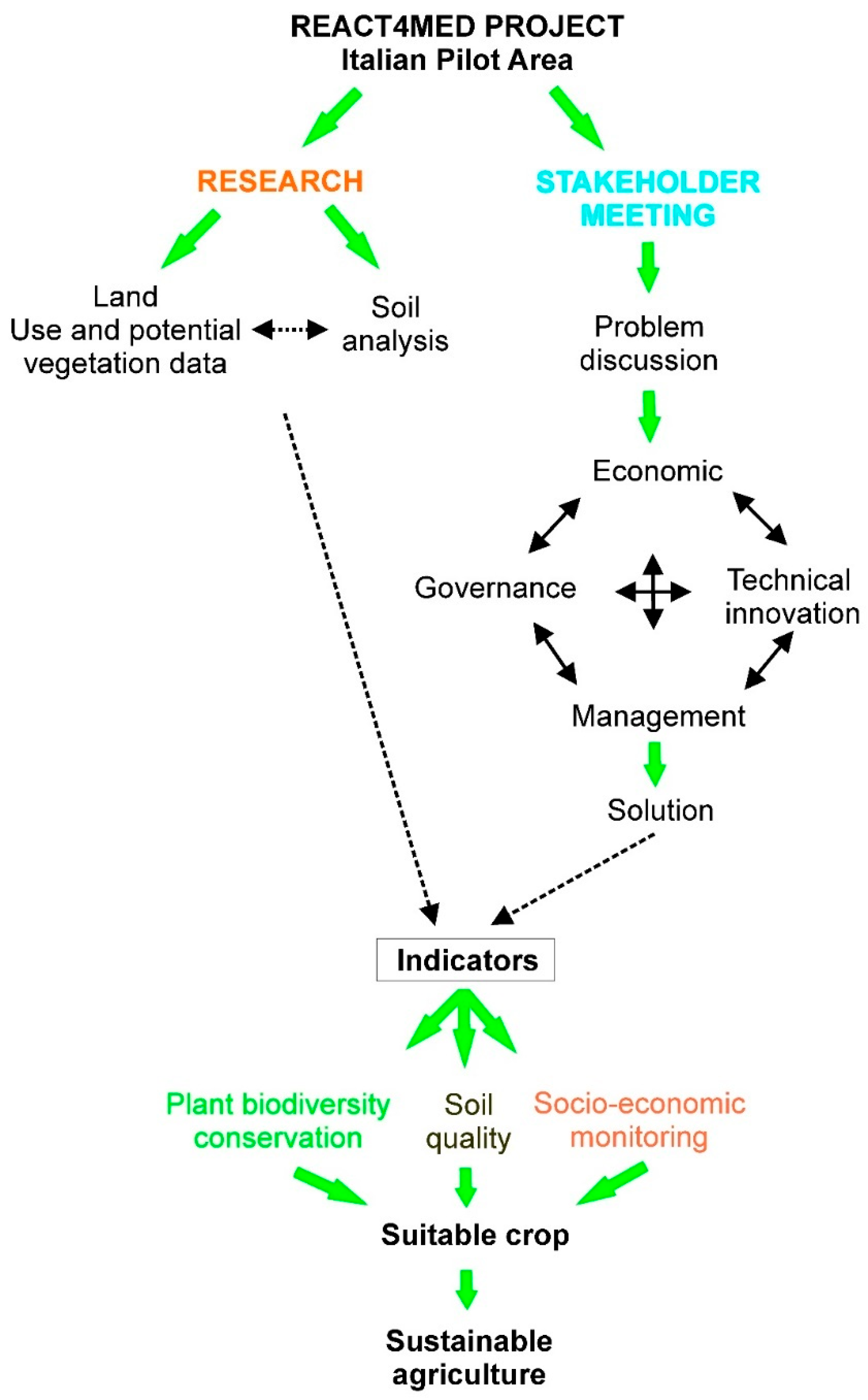
Disclaimer/Publisher’s Note: The statements, opinions and data contained in all publications are solely those of the individual author(s) and contributor(s) and not of MDPI and/or the editor(s). MDPI and/or the editor(s) disclaim responsibility for any injury to people or property resulting from any ideas, methods, instructions or products referred to in the content. |
© 2025 by the authors. Licensee MDPI, Basel, Switzerland. This article is an open access article distributed under the terms and conditions of the Creative Commons Attribution (CC BY) license (https://creativecommons.org/licenses/by/4.0/).
Share and Cite
Perrino, E.V.; Zdruli, P.; Piscitelli, L.; D’Agostino, D. Restoration, Indicators, and Participatory Solutions: Addressing Water Scarcity in Mediterranean Agriculture. Agronomy 2025, 15, 1517. https://doi.org/10.3390/agronomy15071517
Perrino EV, Zdruli P, Piscitelli L, D’Agostino D. Restoration, Indicators, and Participatory Solutions: Addressing Water Scarcity in Mediterranean Agriculture. Agronomy. 2025; 15(7):1517. https://doi.org/10.3390/agronomy15071517
Chicago/Turabian StylePerrino, Enrico Vito, Pandi Zdruli, Lea Piscitelli, and Daniela D’Agostino. 2025. "Restoration, Indicators, and Participatory Solutions: Addressing Water Scarcity in Mediterranean Agriculture" Agronomy 15, no. 7: 1517. https://doi.org/10.3390/agronomy15071517
APA StylePerrino, E. V., Zdruli, P., Piscitelli, L., & D’Agostino, D. (2025). Restoration, Indicators, and Participatory Solutions: Addressing Water Scarcity in Mediterranean Agriculture. Agronomy, 15(7), 1517. https://doi.org/10.3390/agronomy15071517







